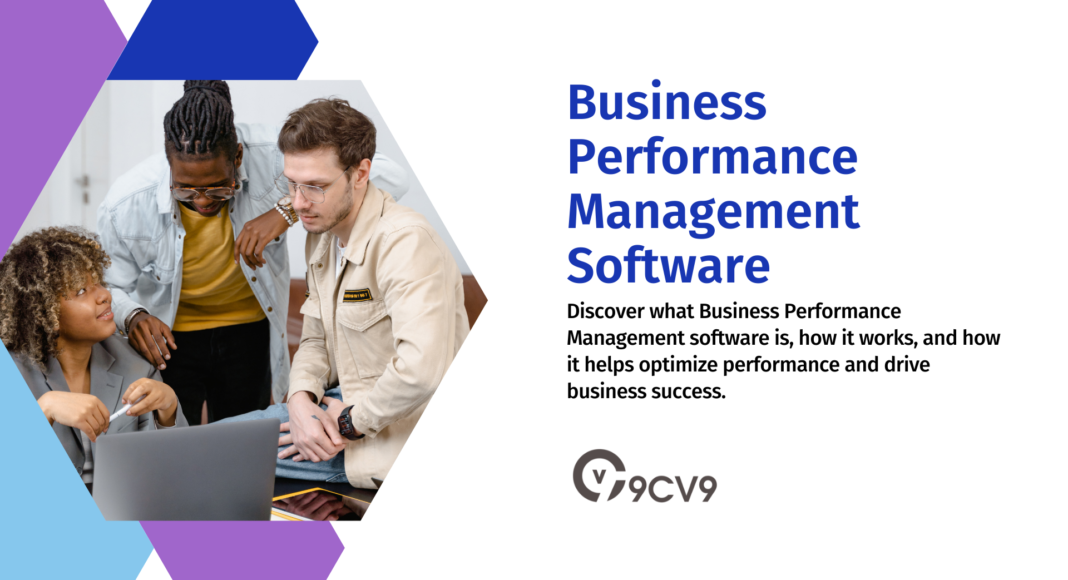Key Takeaways
- Business Performance Management (BPM) software helps track, analyze, and optimize business performance through real-time data and KPIs.
- It enables data-driven decision-making, enhances operational efficiency, and improves cross-departmental collaboration.
- BPM software offers customizable features to align with specific business needs, fostering growth and competitive advantage.
In today’s fast-paced and data-driven business environment, organizations face increasing pressure to improve efficiency, drive growth, and maintain competitive advantages.
Business Performance Management (BPM) software has emerged as an indispensable tool for companies aiming to streamline their operations, make data-backed decisions, and align their strategic objectives with day-to-day activities.
By leveraging sophisticated analytics, real-time reporting, and integrated systems, BPM software provides businesses with a comprehensive view of their performance, helping leaders identify areas for improvement, optimize resources, and achieve organizational goals.

At its core, Business Performance Management software is designed to track, measure, and manage key performance indicators (KPIs), financial metrics, and operational benchmarks.
BPM software integrates data from multiple sources, including financial systems, customer relationship management (CRM) tools, and enterprise resource planning (ERP) platforms, into one unified system.
This consolidation enables businesses to gain a holistic view of their performance across different departments, from finance to human resources, production, and beyond.
The ultimate goal is to enhance organizational efficiency, foster collaboration, and improve decision-making across all levels of management.
As companies increasingly shift towards data-centric operations, the demand for BPM software has skyrocketed.
It is no longer enough to rely on traditional methods of performance measurement, such as quarterly reports and manual analysis.
Instead, BPM software allows businesses to continuously monitor and adjust their strategies, empowering them to be more agile in a rapidly changing market landscape.
Through real-time data insights, predictive analytics, and customizable dashboards, businesses can proactively identify opportunities for improvement, avoid potential pitfalls, and make informed decisions that directly impact their bottom line.
This blog delves into the fundamental aspects of Business Performance Management software, exploring what it is, how it works, and why it has become a crucial component for businesses of all sizes.
Whether you’re looking to implement BPM software in your organization, understand its core features, or optimize your current system, this guide will provide a comprehensive overview of how BPM software functions and how it can revolutionize your approach to business performance management.
Stay tuned as we explore the various facets of BPM software, from its essential features and key benefits to its role in aligning business goals with operational strategies.
We’ll also take a closer look at how you can leverage BPM systems to drive measurable success and gain a competitive edge in the marketplace.
If you’re ready to harness the power of data and performance insights, read on to learn how Business Performance Management software can be a game-changer for your business.
Before we venture further into this article, we would like to share who we are and what we do.
About 9cv9
9cv9 is a business tech startup based in Singapore and Asia, with a strong presence all over the world.
With over nine years of startup and business experience, and being highly involved in connecting with thousands of companies and startups, the 9cv9 team has listed some important learning points in this overview of What is Business Performance Management Software and How It Works.
If your company needs recruitment and headhunting services to hire top-quality employees, you can use 9cv9 headhunting and recruitment services to hire top talents and candidates. Find out more here, or send over an email to [email protected].
Or just post 1 free job posting here at 9cv9 Hiring Portal in under 10 minutes.
What is Business Performance Management Software and How It Works
- What is Business Performance Management Software?
- How Does Business Performance Management Software Work?
- Core Benefits of Using Business Performance Management Software
- Common Features of Business Performance Management Software
- Types of Business Performance Management Software
- How to Choose the Right Business Performance Management Software for Your Business
- Challenges of Implementing Business Performance Management Software
- Best Practices for Effectively Using Business Performance Management Software
1. What is Business Performance Management Software?
Business Performance Management (BPM) software refers to a suite of applications and tools designed to help businesses track, measure, and manage their performance against predefined goals and KPIs. By centralizing data and providing powerful analytics, BPM software enables organizations to monitor progress, identify potential issues, and adjust strategies for optimal performance. BPM software can be used across various departments, including finance, human resources, sales, and operations, providing a comprehensive view of business health and driving improved decision-making.
Core Functions of BPM Software
BPM software serves as a central hub for monitoring business performance. Its core functions include:
- Data Integration:
- Aggregates data from various sources such as CRM systems, financial software, and ERP platforms.
- Ensures all departments have a single, unified view of business performance.
- Examples: A manufacturing company might integrate data from its production line, sales figures, and supply chain systems.
- Key Performance Indicator (KPI) Tracking:
- Helps businesses track critical metrics to gauge success.
- Allows managers to measure individual, departmental, and organizational performance against predefined goals.
- Example: A retail chain may track KPIs like sales per employee, inventory turnover, and customer satisfaction scores.
- Real-time Analytics and Reporting:
- Provides dynamic, up-to-date insights into business operations.
- Uses dashboards and visualization tools to display key metrics, trends, and anomalies.
- Example: A digital marketing agency may monitor website traffic, lead conversions, and social media engagement in real time.
- Strategic Alignment:
- Ensures that all company activities and resources align with business objectives.
- Aligns both financial and non-financial goals to improve overall organizational coherence.
- Example: A company focused on customer experience may set performance goals related to customer satisfaction, which aligns with its long-term growth strategy.
Key Features of Business Performance Management Software
Business Performance Management software is packed with a variety of features designed to optimize business performance. Some of the most essential features include:
- Customizable Dashboards:
- BPM software offers customizable dashboards that can be tailored to display the most relevant performance data for specific users or departments.
- Example: A CFO may view financial KPIs, while an operations manager may track production metrics on their personalized dashboard.
- Scenario Planning and Forecasting:
- Provides tools to predict future performance based on historical data and current trends.
- Enables “what-if” analysis to evaluate different business scenarios.
- Example: A retailer could use scenario planning to understand how different marketing strategies might impact sales revenue.
- Budgeting and Financial Planning (FP&A):
- Assists in creating budgets, allocating resources, and forecasting financial outcomes.
- Integrates with accounting and finance systems for accurate financial projections.
- Example: A SaaS company may use BPM software to create revenue forecasts and allocate resources for product development.
- Collaboration Tools:
- Many BPM systems include tools to foster collaboration across teams and departments.
- Examples include shared performance reports, action plan updates, and real-time notifications.
- Example: A global enterprise might use collaboration features in BPM software to communicate performance updates across its regional teams.
How BPM Software Integrates with Other Business Systems
One of the major advantages of BPM software is its ability to integrate with other essential business tools. This interoperability ensures a seamless flow of data and enables cross-departmental performance tracking. Key integrations include:
- Enterprise Resource Planning (ERP):
- BPM software integrates with ERP systems to track operational and financial data in real time.
- Example: A manufacturing company could track production performance alongside financial performance by integrating BPM with ERP.
- Customer Relationship Management (CRM):
- Integrates with CRM systems to provide a full view of sales performance and customer satisfaction metrics.
- Example: A company using Salesforce for CRM could connect it to BPM software to track lead conversions, sales goals, and customer retention.
- Human Resource Management Systems (HRMS):
- BPM systems can connect with HR software to track employee performance, productivity, and engagement.
- Example: A company may use BPM software to track employee sales targets and performance in alignment with business objectives.
- Business Intelligence (BI) Tools:
- Many BPM solutions come equipped with advanced analytics and business intelligence capabilities.
- Example: A retail company can combine BI with BPM software to gain deeper insights into sales trends, customer behavior, and market conditions.
The Role of BPM Software in Driving Organizational Success
BPM software plays a vital role in helping organizations improve performance, optimize resources, and drive growth. Key ways in which BPM software drives business success include:
- Increased Visibility into Performance Metrics:
- Provides comprehensive visibility into operational and financial metrics.
- Example: A global logistics firm may use BPM software to monitor delivery times, route efficiency, and inventory turnover for each region.
- Faster and More Accurate Decision-Making:
- Real-time data access enables quicker, more informed decision-making.
- Example: A restaurant chain can use BPM software to adjust menus and marketing strategies based on real-time sales performance.
- Improved Resource Allocation:
- BPM software helps businesses allocate resources more effectively by identifying areas that need investment or improvement.
- Example: A tech startup might use BPM software to identify which product features generate the most revenue and allocate resources to enhance them.
- Enhanced Accountability and Alignment:
- By tracking and measuring individual and team performance against business objectives, BPM software promotes greater accountability.
- Example: In a sales organization, each sales representative may have performance targets tracked and reported, aligning them with the company’s revenue goals.
Relevant Examples of Business Performance Management Software
Several BPM solutions are widely used across industries for various business performance needs. These tools offer unique features tailored to specific industries and organizational goals.
- Adaptive Insights:
- Provides financial planning, budgeting, and forecasting tools for organizations across all industries.
- Known for its user-friendly interface and strong analytics capabilities.
- Example: A healthcare provider could use Adaptive Insights to track revenue from insurance claims and adjust budgets accordingly.
- Tableau:
- While primarily a data visualization tool, Tableau integrates well with BPM software to provide real-time performance insights.
- Example: A marketing agency may use Tableau alongside BPM software to visualize customer acquisition costs, conversion rates, and overall campaign performance.
- Oracle Enterprise Performance Management (EPM):
- A robust BPM solution offering features for budgeting, forecasting, and financial close processes.
- Example: A multinational corporation may use Oracle EPM to manage its financial performance across multiple countries and currencies.
- Anaplan:
- A cloud-based BPM solution that specializes in business modeling and planning.
- Example: A manufacturing firm might use Anaplan to optimize its supply chain and manage production schedules, while also tracking the performance of its sales team.
Conclusion
Business Performance Management software is a transformative tool for companies aiming to streamline operations, align organizational objectives, and make data-driven decisions. By providing real-time analytics, integrated data, and performance tracking, BPM software enables businesses to monitor their performance holistically, identify areas for improvement, and achieve their strategic goals more efficiently. With the right BPM system in place, businesses can unlock new growth opportunities and stay competitive in today’s ever-changing market landscape.
2. How Does Business Performance Management Software Work?
Business Performance Management (BPM) software operates as a centralized system designed to help organizations track, manage, and optimize their performance by integrating data, aligning business strategies with operational goals, and using analytics for continuous improvement. Understanding how BPM software works is crucial for businesses that want to maximize the potential of their performance management systems and enhance their decision-making processes. Below, we explore the essential mechanics of BPM software, highlighting its key processes and the value it brings to businesses.
1. Data Collection and Integration
The foundation of BPM software is its ability to collect and integrate data from various business systems. This data serves as the primary input for performance tracking and analysis.
- Data Aggregation:
- Collects data from different business applications, including CRM, ERP, HRMS, and financial systems.
- Automatically consolidates data into a centralized platform to ensure consistency across the organization.
- Example: A financial services company may pull data from its CRM for customer performance metrics and from its ERP for financial operations to assess overall performance.
- Real-time Data Sync:
- BPM software offers real-time data syncing capabilities to ensure up-to-the-minute performance tracking.
- This functionality allows businesses to react to any performance issues quickly and efficiently.
- Example: An e-commerce business can monitor inventory levels, sales transactions, and customer behaviors in real time to optimize stock levels and sales strategies.
- Data Normalization and Cleaning:
- Ensures that data from various sources is in a standardized format, enabling accurate comparisons and analysis.
- Cleanses data to remove any inconsistencies, duplicates, or errors that might distort insights.
- Example: A global enterprise may receive data from regional offices, and BPM software standardizes this data to allow for accurate global performance analysis.
2. Performance Metrics and KPIs Setup
Once the data is collected, BPM software allows businesses to set, track, and measure performance against key metrics and indicators. This helps align daily operations with strategic business goals.
- Defining Key Performance Indicators (KPIs):
- Businesses define KPIs that are specific, measurable, achievable, relevant, and time-bound (SMART).
- These KPIs are aligned with business objectives and can vary by department, such as financial metrics, sales targets, customer satisfaction, and operational efficiency.
- Example: A manufacturing company may define KPIs like production downtime, unit cost, and throughput time to measure operational efficiency.
- Customizable Dashboards for Metrics:
- BPM software allows the creation of custom dashboards where users can see their relevant KPIs in real time.
- Dashboards display visual representations of performance data, such as charts, graphs, and tables, making it easier for managers to analyze trends and performance.
- Example: A marketing manager can view KPIs such as conversion rates, customer acquisition costs, and engagement metrics on a customized dashboard in BPM software.
- Automated Reporting:
- BPM software can automate the process of generating performance reports at different levels (departmental, team, or organization-wide).
- These reports can be scheduled for regular updates (e.g., daily, weekly, monthly) and customized based on user preferences.
- Example: A retail chain may use automated reporting to track sales performance at each store, helping regional managers monitor and compare performance.
3. Real-time Analytics and Insights
A critical aspect of BPM software is its analytical capabilities. These tools provide organizations with the ability to make data-driven decisions in real time, based on actionable insights.
- Data Visualization Tools:
- Provides interactive charts, graphs, heat maps, and other visual aids to present complex performance data in an easy-to-understand format.
- Visualization tools help identify trends, anomalies, and areas of concern quickly.
- Example: A logistics company can use BPM software’s data visualization tools to analyze delivery performance across different regions and identify any bottlenecks in the supply chain.
- Predictive Analytics and Forecasting:
- BPM software incorporates predictive analytics to forecast future trends based on historical data.
- Allows businesses to simulate various scenarios, helping them plan better for future outcomes.
- Example: A telecom company can forecast customer churn rates and predict future service demands, enabling proactive actions to retain customers and adjust service offerings.
- Root Cause Analysis:
- Helps businesses identify the root causes of performance issues by analyzing data patterns and drilling down into problem areas.
- Example: A hotel chain might use BPM software to investigate why certain locations are underperforming, using customer feedback and booking trends to identify operational inefficiencies.
4. Continuous Monitoring and Adjustments
BPM software enables businesses to continuously monitor performance, track deviations from goals, and make necessary adjustments to improve results.
- Real-time Performance Monitoring:
- Constantly tracks business performance against set KPIs and thresholds.
- Flags deviations or performance gaps and provides alerts or notifications for immediate action.
- Example: A software development company can use BPM software to monitor project milestones, identifying if any development cycle is falling behind and prompting managers to take corrective measures.
- Performance Benchmarking:
- BPM software enables businesses to benchmark performance against industry standards or best practices.
- Helps organizations understand where they stand compared to competitors or market leaders.
- Example: An airline may benchmark its on-time performance against industry averages to gauge how well it is performing relative to competitors.
- Adjusting Business Strategies:
- Based on real-time monitoring, BPM software empowers managers to adjust strategies, tactics, and resource allocation to improve performance.
- Example: A marketing team can modify its campaign budget allocation based on the real-time performance of digital ads tracked in the BPM system.
5. Collaboration and Decision-Making Tools
BPM software is not only a performance tracking tool but also a collaborative platform that promotes communication and decision-making across teams.
- Collaboration Features:
- BPM software integrates communication tools such as shared reports, feedback systems, and project management features to facilitate team collaboration.
- Teams can discuss performance insights, share action plans, and collectively work towards resolving performance gaps.
- Example: A global retail brand uses BPM software’s collaboration tools to enable its regional managers to share performance insights and best practices.
- Actionable Alerts and Notifications:
- Managers receive notifications and alerts on critical issues such as performance deviations, high-priority KPIs, or underperforming departments.
- These alerts are often linked to specific action plans or suggestions for improvement.
- Example: An HR department can receive an alert if employee productivity metrics fall below the threshold, prompting immediate action to address the issue.
- Role-based Access and Decision Rights:
- BPM software offers role-based access, ensuring that the right stakeholders have access to the data and performance metrics they need to make decisions.
- Ensures accountability at different organizational levels.
- Example: A CEO may have access to high-level performance summaries, while department heads only have access to data relevant to their teams.
6. Strategy Execution and Alignment
BPM software facilitates the alignment of organizational strategies with daily operations, helping businesses execute their goals more effectively.
- Strategic Planning Integration:
- BPM software integrates strategic business planning with execution, ensuring that all performance metrics and goals align with the company’s long-term vision.
- Example: A financial institution uses BPM software to ensure that its growth objectives align with its performance indicators across departments, including risk management and customer service.
- Goal Cascading:
- The software allows businesses to cascade high-level strategic goals down to individual and team performance objectives.
- Example: A telecommunications company can cascade its corporate goal of expanding its customer base by setting sales and marketing goals at a departmental level, ensuring alignment across all levels of the organization.
7. Reporting and Review
Once the performance is tracked and monitored, BPM software generates detailed reports that can be reviewed by leadership to ensure continuous improvement.
- Executive-Level Reports:
- High-level, comprehensive reports summarizing business performance across departments.
- Provide executives with a clear picture of the organization’s health and progress toward strategic goals.
- Example: A multinational corporation can review quarterly reports showing how all its regional branches are performing against their local targets.
- Historical Data Review:
- Allows businesses to review historical performance data for trends, seasonality, and long-term analysis.
- Example: A fashion retailer may analyze historical sales data across seasons to optimize product offerings for upcoming fashion trends.
- Feedback and Actionable Recommendations:
- BPM software not only tracks data but also provides actionable recommendations based on the insights gathered.
- Example: A construction company might receive recommendations on improving project timelines based on real-time performance analysis.
Conclusion
Business Performance Management software works by centralizing data, tracking performance against KPIs, and providing analytics to ensure businesses are operating at optimal efficiency. Through continuous monitoring, real-time insights, and collaborative features, BPM software empowers businesses to make informed decisions, align strategies with goals, and enhance performance across departments. By integrating data from various systems, forecasting future trends, and providing actionable feedback, BPM software ensures that businesses can adapt to changing environments and drive sustained growth.
3. Core Benefits of Using Business Performance Management Software
Business Performance Management (BPM) software offers an array of strategic advantages that enable organizations to optimize their operations, track progress toward goals, and drive continuous improvement. These tools are essential for businesses aiming to streamline processes, enhance decision-making, and align strategies with performance metrics. In this section, we explore the core benefits of using BPM software, with relevant examples to illustrate how it transforms business operations.
1. Improved Decision-Making
BPM software equips businesses with real-time data and analytics, empowering decision-makers to make informed, data-driven decisions. By consolidating data across departments, BPM tools enhance the accuracy of business insights.
- Data-Driven Insights:
- Collects data from various business systems and integrates it into a centralized platform, providing clear insights into organizational performance.
- Decision-makers can base their actions on reliable and up-to-date information, avoiding guesswork and assumptions.
- Example: A retail chain uses BPM software to monitor sales trends, enabling executives to adjust inventory levels and promotional strategies based on current consumer behavior.
- Real-time Reporting and Analytics:
- With real-time data analysis, businesses can make adjustments swiftly, minimizing the impact of negative trends or performance gaps.
- Example: A manufacturing plant uses BPM software to track production efficiency and make real-time decisions to address machinery downtime or quality control issues.
- Predictive Analytics:
- BPM software integrates predictive analytics, helping businesses forecast future trends and performance outcomes.
- Decision-makers can proactively address challenges before they impact overall business goals.
- Example: A logistics company uses predictive analytics to forecast demand for delivery services during peak seasons, allowing for optimal resource allocation.
2. Enhanced Strategic Alignment
One of the primary advantages of BPM software is its ability to align day-to-day operations with overarching strategic goals. By establishing clear key performance indicators (KPIs) and monitoring progress, BPM software ensures that all departments work in harmony towards the same objectives.
- Goal Cascading:
- BPM tools allow businesses to cascade high-level strategic goals to departmental and individual objectives.
- This ensures that every level of the organization understands how their work contributes to larger business objectives.
- Example: A global technology company aligns its research and development goals with company-wide objectives, ensuring that the R&D department is focused on innovations that support long-term growth.
- Better Resource Allocation:
- BPM software helps businesses allocate resources more effectively by aligning them with the most critical performance areas.
- This ensures optimal use of resources, whether it’s time, talent, or budget.
- Example: A multinational company uses BPM software to allocate marketing budgets based on performance metrics, ensuring funds are directed to the most effective channels.
- Consistency in Execution:
- With a unified performance management system, BPM software helps maintain consistency in executing business strategies across all departments.
- Example: A financial services firm uses BPM software to ensure that all teams follow consistent performance benchmarks and best practices, from client acquisition to financial reporting.
3. Increased Operational Efficiency
BPM software allows businesses to identify inefficiencies and optimize processes, resulting in better overall productivity and cost reduction. By tracking operational performance and providing insights, BPM software helps organizations pinpoint bottlenecks and streamline workflows.
- Process Optimization:
- BPM software helps businesses evaluate and optimize their existing workflows by identifying bottlenecks and inefficiencies in operations.
- Example: A logistics company uses BPM software to track supply chain performance and reduce delays, resulting in faster delivery times and lower operational costs.
- Automated Reporting and Monitoring:
- BPM software automates routine tasks, such as data collection, performance reporting, and KPI tracking, saving time and reducing the chances of errors.
- Example: An HR department uses BPM software to automatically track employee performance and generate reports, reducing the time spent on manual data entry and allowing HR managers to focus on strategic initiatives.
- Resource and Capacity Planning:
- BPM tools help businesses optimize their resource utilization by assessing workloads and capacity, enabling them to plan more effectively for the future.
- Example: A software development company uses BPM software to analyze project timelines and allocate developers based on skill sets and availability, reducing project delays and optimizing delivery times.
4. Improved Accountability and Transparency
BPM software fosters a culture of accountability and transparency by providing clear visibility into individual and team performance. Managers can easily track progress against targets, ensuring everyone is aligned and responsible for their contributions.
- Clear KPI Tracking:
- BPM software allows businesses to define and track specific KPIs for every department and employee, providing clear expectations for performance.
- Example: A retail chain uses BPM software to set KPIs for sales associates, such as monthly sales targets and customer satisfaction scores, ensuring accountability at all levels.
- Transparent Performance Evaluation:
- The software provides transparent data that helps managers conduct objective performance evaluations.
- This ensures fairness and supports constructive feedback for continuous improvement.
- Example: A healthcare organization uses BPM software to assess the performance of medical staff and provide targeted feedback, improving patient care standards.
- Visibility into Organizational Performance:
- BPM tools provide transparency into overall organizational performance, which can be shared across departments to encourage collaboration and alignment.
- Example: A tech company uses BPM software to make performance data accessible to all team members, encouraging cross-departmental collaboration and shared responsibility for achieving corporate goals.
5. Greater Agility and Flexibility
In today’s fast-paced business environment, agility is essential for staying competitive. BPM software enables businesses to adapt quickly to changing market conditions and shifting customer demands, ensuring they remain flexible in their approach.
- Real-Time Adjustments:
- BPM software allows businesses to make real-time adjustments based on performance data, ensuring quick responses to emerging opportunities or challenges.
- Example: A travel agency uses BPM software to adjust pricing strategies in real time based on demand fluctuations, optimizing revenue generation during peak travel periods.
- Scenario Planning:
- BPM software supports scenario planning, enabling businesses to simulate various outcomes and adjust strategies accordingly.
- Example: A fashion retailer uses BPM software to forecast sales under different economic conditions, allowing for proactive inventory management and marketing strategies.
- Adaptation to Market Changes:
- By continuously monitoring performance metrics, BPM software enables businesses to pivot or adjust strategies to remain relevant as market conditions evolve.
- Example: A food manufacturer uses BPM software to monitor consumer preferences and trends, allowing them to adjust product offerings or marketing campaigns to meet customer demand.
6. Enhanced Collaboration Across Teams
BPM software promotes collaboration by providing a platform where teams can share insights, discuss performance data, and work together toward common goals. This ensures that all departments are working in unison to drive organizational success.
- Centralized Data Sharing:
- BPM software centralizes data, making it easily accessible to all stakeholders across the organization.
- This eliminates silos and encourages open communication between teams.
- Example: A global consulting firm uses BPM software to share performance metrics between teams across different regions, enabling collaboration on strategies to improve client satisfaction.
- Integrated Communication Tools:
- Many BPM tools include built-in communication features, such as instant messaging, file sharing, and task assignment, to facilitate team coordination.
- Example: A software development team uses BPM software’s collaboration features to assign tasks, share code reviews, and track progress, ensuring seamless project delivery.
- Collaborative Decision-Making:
- BPM software provides teams with access to the same real-time data, enabling collaborative decision-making based on a unified understanding of performance.
- Example: A product development team uses BPM software to analyze customer feedback and sales data, collaboratively making decisions on feature prioritization.
7. Better Compliance and Risk Management
With built-in tracking, reporting, and monitoring features, BPM software helps businesses manage compliance requirements and mitigate potential risks, ensuring adherence to regulations and industry standards.
- Automated Compliance Tracking:
- BPM software tracks compliance metrics, automating the monitoring of relevant regulations and ensuring businesses stay compliant.
- Example: A financial institution uses BPM software to track regulatory requirements and performance metrics, ensuring it meets industry standards and avoids fines.
- Risk Identification and Mitigation:
- By analyzing performance data, BPM software can highlight potential risks, allowing businesses to take proactive steps to mitigate them.
- Example: A manufacturing company uses BPM software to monitor equipment performance and predict when machines are likely to break down, reducing the risk of costly repairs or production delays.
- Audit and Reporting Capabilities:
- BPM software provides detailed audit trails and reporting features to ensure that businesses can demonstrate compliance during audits.
- Example: A healthcare provider uses BPM software to generate compliance reports for patient data security, ensuring they meet HIPAA requirements.
Conclusion
The core benefits of using Business Performance Management software are vast and varied, ranging from improved decision-making and enhanced operational efficiency to better strategic alignment and increased accountability. By consolidating data, tracking performance in real time, and fostering collaboration, BPM software empowers businesses to optimize processes, adapt to market changes, and drive sustained growth. With real-world examples across industries like retail, manufacturing, healthcare, and finance, it is clear that BPM software is an invaluable tool for modern organizations looking to stay competitive in an increasingly data-driven world.
4. Common Features of Business Performance Management Software
Business Performance Management (BPM) software is a vital tool for organizations aiming to optimize operations, track progress, and ensure alignment with strategic objectives. These tools come equipped with a variety of features designed to streamline decision-making, improve collaboration, and enhance overall business performance. In this section, we will delve into the most common features of BPM software, highlighting their importance with relevant examples to help businesses understand how these functionalities can drive success.
1. Real-Time Data Analytics
Real-time data analytics is one of the most critical features of BPM software, allowing businesses to gather and analyze performance data instantaneously. This feature helps organizations make data-driven decisions and respond swiftly to emerging trends or challenges.
- Instant Access to Key Metrics:
- BPM software provides real-time updates on key performance indicators (KPIs), giving stakeholders immediate access to vital information.
- Example: A financial services firm uses real-time analytics to monitor investment portfolio performance, allowing portfolio managers to make adjustments based on market fluctuations.
- Dynamic Dashboards:
- Most BPM tools come with customizable dashboards that display live data visualizations, providing users with a comprehensive view of organizational performance at a glance.
- Example: A manufacturing company uses a dynamic dashboard to monitor production efficiency in real time, helping managers spot issues like equipment malfunctions as they occur.
- Trend Analysis and Forecasting:
- BPM software can analyze historical data and use predictive analytics to forecast future trends, helping businesses plan for potential opportunities or risks.
- Example: An e-commerce company uses real-time analytics to predict demand for specific products, adjusting inventory levels before peak seasons like Black Friday.
2. Goal Setting and Alignment
BPM software enables organizations to set, track, and align business goals with day-to-day operations, ensuring that all employees work toward the same strategic objectives.
- Cascading Goals:
- This feature allows organizations to break down high-level strategic goals into departmental and individual objectives, ensuring alignment across all levels.
- Example: A healthcare provider sets a corporate goal of improving patient care quality, which is then broken down into specific goals for departments such as surgery, diagnostics, and nursing.
- SMART Goal Framework:
- BPM tools often use the SMART (Specific, Measurable, Achievable, Relevant, Time-bound) framework to define clear and actionable goals.
- Example: A sales team uses BPM software to set specific targets for revenue growth, client acquisition, and product sales within a given time frame.
- Progress Tracking:
- These platforms allow users to monitor progress against set goals and adjust strategies accordingly if targets are not met.
- Example: A tech startup uses BPM software to track milestones for software development projects, adjusting deadlines or resource allocation when goals are not being met.
3. Performance Dashboards and Reporting
Performance dashboards and reporting capabilities allow businesses to visualize data and monitor key metrics, making it easier to assess whether the organization is on track to meet its goals.
- Customizable Dashboards:
- BPM software often offers the ability to create personalized dashboards that display only the most relevant KPIs and performance data, helping decision-makers focus on what matters most.
- Example: A retail chain uses a customizable dashboard to track metrics such as store sales, customer satisfaction, and stock availability across different locations.
- Comprehensive Reporting:
- Detailed, automated reports are generated based on collected data, providing in-depth insights into organizational performance.
- Example: A logistics company uses automated reports to track shipping delays, inventory levels, and route optimization performance, generating monthly performance reports for management.
- Interactive Visualizations:
- BPM software frequently incorporates interactive charts, graphs, and heat maps, making it easy for users to visualize trends and identify areas needing attention.
- Example: A marketing team uses visualizations to track the performance of various ad campaigns, adjusting strategies in real-time based on conversion rates and customer engagement data.
4. Forecasting and Scenario Planning
Forecasting and scenario planning are essential features that enable businesses to predict future trends, optimize resource allocation, and minimize risks. These capabilities are particularly useful for companies facing an unpredictable business environment.
- Predictive Analytics:
- BPM software utilizes predictive algorithms to forecast future business outcomes based on historical data and trends.
- Example: A retail company uses predictive analytics to forecast demand during holiday seasons, optimizing inventory levels and staffing requirements in advance.
- Scenario Modeling:
- This feature allows businesses to simulate different business scenarios and assess the potential impact of various decisions.
- Example: A manufacturing company uses scenario modeling to simulate the impact of raw material price changes on production costs, helping them plan for price fluctuations.
- What-If Analysis:
- BPM tools support “what-if” analysis, enabling users to assess different hypothetical situations and predict the effects of specific actions or decisions.
- Example: An insurance company uses what-if analysis to evaluate how changes in policy pricing might affect customer retention and revenue.
5. Integration with Other Business Systems
Effective BPM software integrates seamlessly with other business systems and tools, such as Enterprise Resource Planning (ERP), Customer Relationship Management (CRM), and Human Resource Management (HRM) systems, ensuring a unified view of performance across the organization.
- Unified Data Ecosystem:
- Integration ensures that all departments have access to the same data, eliminating silos and fostering collaboration.
- Example: A technology firm integrates its BPM software with its CRM system, allowing sales teams to track customer interactions alongside revenue data for more effective client relationship management.
- Automated Data Flow:
- By automating data synchronization between systems, BPM tools reduce the need for manual data entry and ensure accuracy across business functions.
- Example: A supply chain management company integrates BPM software with inventory management systems to automatically update stock levels, reducing the risk of stockouts or overstocking.
- Third-Party Integrations:
- Many BPM platforms offer pre-built connectors to other third-party tools, such as project management software, financial platforms, and marketing automation tools.
- Example: A SaaS company integrates BPM software with its marketing automation system to monitor lead generation efforts alongside sales conversion rates.
6. Collaboration and Communication Tools
BPM software encourages team collaboration and communication, ensuring that all stakeholders remain aligned and informed about organizational performance.
- Shared Dashboards and Reports:
- BPM tools allow users to share dashboards and reports with colleagues, making it easy to collaborate and make decisions based on real-time performance data.
- Example: A consulting firm uses BPM software to share client project dashboards with team members, ensuring that all stakeholders are aware of project progress and any potential issues.
- Task Assignment and Workflow Management:
- BPM software often includes workflow management capabilities that allow teams to assign tasks, set deadlines, and track project progress.
- Example: A marketing agency uses BPM software to assign content creation tasks to team members, track completion statuses, and ensure timely delivery of campaigns.
- Real-Time Notifications and Alerts:
- Automated alerts notify teams when performance deviates from expected metrics, ensuring that immediate corrective actions can be taken.
- Example: A production facility uses real-time alerts to notify supervisors if machine performance drops below optimal levels, allowing them to address issues before production is affected.
7. Customization and Flexibility
BPM software offers customization options that allow businesses to tailor the software to their specific needs, whether that involves adjusting KPIs, designing custom dashboards, or configuring workflows.
- Customizable KPIs:
- BPM software allows businesses to define and track KPIs that are aligned with their specific business goals.
- Example: A software development firm customizes its BPM software to track specific KPIs, such as software bugs per release and development cycle time.
- Flexible Workflow Design:
- Companies can configure workflows to suit their internal processes, whether it’s for approvals, reporting, or performance reviews.
- Example: A government agency customizes its BPM software to manage the approval process for procurement, ensuring compliance with regulations.
- Adaptability Across Industries:
- BPM software can be tailored for different industries, offering industry-specific features or integrations that support diverse business needs.
- Example: A healthcare provider customizes BPM software to track patient satisfaction metrics, while a retail business uses the software to optimize inventory management and supply chain operations.
8. Compliance and Risk Management Features
BPM software helps businesses adhere to regulations and mitigate risks by providing tracking tools and compliance monitoring.
- Regulatory Compliance Monitoring:
- BPM tools often include features to monitor and track compliance with industry-specific regulations and standards.
- Example: A financial institution uses BPM software to ensure that all reporting adheres to regulatory requirements, minimizing the risk of compliance violations.
- Audit Trails:
- Many BPM platforms generate detailed audit trails that track changes to performance data, workflows, and documents, which are crucial for regulatory compliance and transparency.
- Example: A pharmaceutical company uses BPM software to maintain an audit trail for all clinical trial data, ensuring adherence to industry regulations.
- Risk Identification and Mitigation:
- BPM software can identify potential risks based on performance data and provide actionable insights for risk mitigation.
- Example: A construction company uses BPM software to monitor safety compliance on job sites, minimizing the risk of accidents and legal liabilities.
Conclusion
Business Performance Management software comes equipped with a wide array of features that enable organizations to manage, track, and optimize their operations. From real-time data analytics and goal alignment to forecasting, collaboration, and compliance management, BPM software plays a central role in driving business success. With customizable options and powerful integrations, BPM platforms cater to a wide variety of business needs, making them indispensable tools for modern organizations seeking to enhance performance and achieve strategic objectives.
5. Types of Business Performance Management Software
Business Performance Management (BPM) software is an essential tool for companies looking to optimize their performance, track progress, and achieve their strategic goals. However, there isn’t a one-size-fits-all solution when it comes to BPM software. Different types of BPM tools are designed to serve specific business needs, industries, and organizational structures. In this section, we will explore the various types of BPM software, highlighting their features, functionalities, and how they address unique business requirements. Relevant examples will be provided to give readers a clearer understanding of how these tools are used in real-world scenarios.
1. Strategic Performance Management Software
Strategic performance management software helps organizations track their long-term business goals and ensure that their actions align with the company’s overarching strategy. This type of BPM software is focused on aligning team objectives with strategic outcomes, improving decision-making, and driving long-term business success.
- Features:
- Goal Setting and Alignment: Allows businesses to set company-wide strategic goals and break them down into smaller, actionable objectives for different departments and teams.
- KPI Tracking: Enables companies to track key performance indicators (KPIs) related to strategic goals, ensuring all efforts contribute to the larger mission.
- Strategy Mapping: Visualizes how various business activities link to the company’s strategic objectives, helping to understand the bigger picture.
- Example:
- Balanced Scorecard Software: A popular tool for strategic performance management, used by organizations like The US Army to track long-term performance across different units, focusing on financial, customer, internal processes, and learning & growth perspectives.
- Best for:
- Large enterprises looking to align operational actions with long-term business goals.
- Companies in sectors like manufacturing, finance, and healthcare, where strategic alignment is critical for success.
2. Financial Performance Management Software
Financial performance management software is designed to help businesses optimize their financial operations, track budgeting, manage forecasting, and ensure compliance with regulations. This type of BPM software focuses primarily on financial data and helps organizations maintain control over their financial health.
- Features:
- Budgeting and Forecasting: Helps businesses create detailed financial forecasts based on historical data, enabling better decision-making for future investments.
- Profitability Analysis: Allows companies to track and assess profitability across different departments, products, or services.
- Cash Flow Management: Provides tools to monitor cash flow, assess financial risks, and improve financial stability.
- Regulatory Compliance: Ensures compliance with financial regulations, reducing the risk of penalties and legal issues.
- Example:
- Oracle Hyperion Financial Management: A comprehensive solution used by large organizations like GEfor financial reporting, budgeting, and analysis. It helps streamline financial processes and improve decision-making through powerful forecasting tools.
- Best for:
- Large corporations or businesses with complex financial structures needing to streamline budgeting, financial forecasting, and regulatory compliance.
- Businesses in finance, insurance, and banking industries where financial performance monitoring is crucial.
3. Operational Performance Management Software
Operational performance management software focuses on improving day-to-day business operations by tracking efficiency, productivity, and the performance of key operational processes. It helps companies monitor their core operations to identify areas for improvement, reduce costs, and boost productivity.
- Features:
- Process Optimization: Tracks operational processes and identifies bottlenecks or inefficiencies that hinder productivity.
- Resource Allocation: Helps businesses allocate resources effectively by tracking usage and optimizing workflows.
- Performance Metrics: Provides insights into key operational metrics, such as production efficiency, delivery times, and inventory management.
- Continuous Improvement: Promotes continuous process improvement by identifying weak areas and suggesting improvements.
- Example:
- SAP BusinessObjects: A popular tool for operational performance management used by companies like Coca-Cola to streamline operations, track inventory, and ensure timely deliveries. It integrates various business processes to enhance productivity and operational performance.
- Best for:
- Manufacturers, retailers, and distribution companies that need to improve production workflows, supply chain management, and operational efficiency.
- Businesses aiming for cost reduction, process automation, and overall optimization of operational tasks.
4. Employee Performance Management Software
Employee performance management software focuses on tracking, evaluating, and enhancing individual employee performance. This type of BPM software is crucial for businesses that want to improve employee engagement, set clear goals, and ensure optimal workforce productivity.
- Features:
- Goal Setting and Tracking: Helps managers set employee-specific goals that align with organizational objectives and track progress over time.
- Performance Reviews: Provides tools for conducting performance reviews, offering feedback, and setting career development plans for employees.
- 360-Degree Feedback: Collects feedback from peers, subordinates, and managers to provide a holistic view of employee performance.
- Learning and Development: Suggests training programs or skill development opportunities based on performance evaluations.
- Example:
- Workday Performance Management: A widely used platform that offers goal setting, performance tracking, and feedback mechanisms, helping companies like Unilever manage employee performance and align individual contributions with organizational success.
- Best for:
- HR departments of large organizations seeking to optimize employee performance, engagement, and professional development.
- Companies in sectors like tech, healthcare, and retail, where employee performance directly impacts organizational outcomes.
5. Customer Performance Management Software
Customer performance management software helps businesses track and analyze customer interactions and satisfaction levels. It focuses on improving customer experience, increasing retention rates, and aligning customer expectations with business objectives.
- Features:
- Customer Satisfaction Surveys: Provides tools for gathering customer feedback, which helps organizations track satisfaction and identify areas for improvement.
- Customer Segmentation: Helps companies segment customers based on behavior, purchasing patterns, or demographics, allowing for more targeted engagement strategies.
- NPS (Net Promoter Score) Tracking: Measures customer loyalty and satisfaction, which can be directly tied to retention rates and overall business performance.
- Customer Lifetime Value (CLV): Tracks the long-term value of customers to the business, helping to focus efforts on high-value clients.
- Example:
- Salesforce Service Cloud: A customer relationship management (CRM) tool that includes customer performance management features like feedback collection, customer segmentation, and NPS tracking. Companies like Adidas use this tool to enhance customer relationships and improve service quality.
- Best for:
- Businesses looking to improve customer service, loyalty, and retention, particularly in customer-facing industries such as retail, telecommunications, and hospitality.
- Organizations that need to understand customer satisfaction and adjust service delivery to meet customer expectations.
6. Supply Chain Performance Management Software
Supply chain performance management software focuses on optimizing the performance of the entire supply chain, from procurement to delivery. This type of BPM software ensures that businesses can efficiently manage their suppliers, inventories, logistics, and distribution networks.
- Features:
- Inventory Management: Monitors stock levels, inventory turnover, and order fulfillment rates to ensure that businesses can meet customer demand without overstocking.
- Supplier Performance Evaluation: Tracks supplier reliability, delivery times, and quality to identify the best-performing vendors.
- Logistics Optimization: Helps optimize delivery routes, minimize delays, and reduce transportation costs.
- Demand Forecasting: Uses historical data to predict future demand and plan the supply chain accordingly.
- Example:
- Kinaxis RapidResponse: A supply chain performance management software used by companies like Caterpillar to manage inventory, evaluate suppliers, and streamline logistics. It offers tools for demand forecasting and supply chain optimization.
- Best for:
- Manufacturing, retail, and distribution companies that need to streamline their supply chain operations, reduce delays, and minimize costs.
- Organizations that face complex supply chains with multiple suppliers and distribution channels.
7. Project Performance Management Software
Project performance management software is tailored to help organizations monitor and optimize the performance of individual projects. This software is focused on ensuring that projects are completed on time, within budget, and meet the desired quality standards.
- Features:
- Project Scheduling and Timeline Management: Helps create detailed project timelines and track progress against milestones.
- Budget Tracking: Monitors project expenses to ensure that costs remain within the allocated budget.
- Risk Management: Identifies potential project risks and provides solutions to mitigate them.
- Collaboration Tools: Enables team collaboration, file sharing, and real-time communication within the project team.
- Example:
- Microsoft Project: A leading project performance management tool used by businesses like Boeing for project scheduling, cost tracking, and team collaboration. It helps ensure that projects are delivered on time and within budget.
- Best for:
- Project-based organizations such as construction firms, IT companies, and consulting firms looking to track and optimize individual project performance.
- Companies that manage multiple projects simultaneously and need centralized tools to oversee project timelines, budgets, and risks.
Conclusion
Understanding the various types of business performance management software is crucial for selecting the right tool to address specific business needs. Whether focusing on strategic alignment, financial management, operational efficiency, or customer satisfaction, BPM software offers specialized features designed to optimize performance across various organizational functions. By choosing the appropriate software type, companies can ensure that they effectively monitor, track, and improve their business performance in a way that drives long-term success.
6. How to Choose the Right Business Performance Management Software for Your Business
Selecting the right Business Performance Management (BPM) software is crucial for organizations aiming to optimize their performance, align their strategies, and drive long-term growth. With numerous BPM software solutions available in the market, choosing the right one can be a daunting task. However, by considering several key factors, businesses can ensure that they select the most suitable BPM software tailored to their unique needs and objectives. This section will guide you through the process of choosing the right BPM software for your business, helping you evaluate options based on your business type, goals, and industry requirements.
1. Understand Your Business Needs and Objectives
Before diving into the selection process, it’s essential to clearly define your business goals and performance management needs. This will allow you to identify the specific features and functionalities required in a BPM tool.
- Key Questions to Ask:
- What are the main performance metrics and KPIs your business needs to track (e.g., financial performance, operational efficiency, customer satisfaction)?
- Are you looking to improve strategic alignment, financial management, operational performance, or employee productivity?
- Do you need tools for goal setting, real-time tracking, or performance forecasting?
- Example:
- A retail company focused on improving customer experience might prioritize features such as customer feedback tracking, customer segmentation, and NPS (Net Promoter Score) analysis in their BPM software. In contrast, a manufacturing company might require stronger tools for inventory management, supplier performance tracking, and demand forecasting.
- Best for:
- Businesses with specific needs that require a solution to align performance metrics and business strategy.
- Organizations in industries such as retail, finance, or manufacturing, where key performance indicators differ.
2. Evaluate Key Features and Functionalities
BPM software varies greatly in terms of features and functionalities. Understanding which features align with your business goals will help ensure you invest in the right tool.
- Core Features to Consider:
- Goal Setting and Tracking: The ability to set measurable objectives, align them with business goals, and track progress in real time.
- KPI Monitoring: Tools that allow you to define, track, and analyze key performance indicators specific to your business.
- Data Analytics and Reporting: Advanced analytics and reporting features that enable data-driven decision-making through dashboards, scorecards, and visualizations.
- Collaboration Tools: Features that foster communication and collaboration between teams, helping to break down silos and align efforts.
- Integration with Existing Systems: The ability to integrate seamlessly with other business systems such as CRM, ERP, HRM, or financial management software.
- Example:
- Oracle Hyperion Performance Management provides advanced financial planning, budgeting, and forecasting tools, making it ideal for large organizations with complex financial structures.
- Workday Performance Management focuses on HR and employee performance tracking, offering tools for goal setting, feedback, and performance evaluations.
- Best for:
- Organizations requiring specific features like financial planning, employee performance tracking, or supply chain performance monitoring.
- Businesses that prioritize data analysis, reporting, and integration with other software.
3. Consider Your Business Size and Complexity
The size and complexity of your business play a significant role in determining which BPM software will be the most effective. Different software solutions are designed for businesses of varying sizes, from small startups to large multinational corporations.
- Small to Medium Enterprises (SMEs):
- These businesses typically need a more affordable, easy-to-use BPM solution with essential features like goal setting, KPI tracking, and basic reporting.
- Cloud-based BPM solutions are often preferred by SMEs due to lower upfront costs, scalability, and ease of deployment.
- Large Enterprises:
- Larger organizations with complex structures may require more robust, customizable BPM tools that can handle multiple departments, large datasets, and advanced analytics.
- These businesses often require enterprise-level integration with other software systems, comprehensive reporting, and multi-user access control.
- Example:
- Smaller businesses might find Zoho People or Monday.com more suited to their needs due to their scalability, user-friendliness, and affordable pricing.
- Large enterprises like Coca-Cola use complex BPM solutions such as SAP BusinessObjects or Oracle Hyperion for performance management across global operations.
- Best for:
- Smaller businesses needing a cost-effective, user-friendly solution with scalable features.
- Large enterprises with intricate performance management needs and integration requirements across multiple departments and locations.
4. Assess Ease of Use and User Interface
A BPM software solution should be intuitive and easy to navigate for all users, from management to employees. A user-friendly interface minimizes the learning curve and increases adoption across teams.
- Key Considerations:
- User Interface (UI): Look for a clean, organized, and visually appealing interface that allows users to quickly find and use the necessary features.
- User Experience (UX): Ensure the software is designed with usability in mind, allowing users to easily track performance, generate reports, and set goals.
- Customization: The software should allow customization of dashboards, reports, and performance metrics to fit your unique business needs.
- Example:
- Tableau is known for its intuitive and highly customizable interface, allowing businesses to visualize data through interactive dashboards. It’s widely used across industries for data-driven performance tracking and analytics.
- Best for:
- Companies that prioritize ease of use and require simple, accessible software that employees can quickly adapt to.
- Organizations that value visual analytics and need an interface that clearly communicates complex performance data.
5. Check for Integration Capabilities
Your BPM software should seamlessly integrate with other business tools and systems, such as CRM, ERP, accounting, and HR software. Integration ensures that performance data is accurate, up-to-date, and consistent across all business functions.
- Important Integrations to Consider:
- ERP Systems: Integration with enterprise resource planning systems allows BPM software to pull financial, operational, and HR data for performance analysis.
- CRM Software: Integrating with customer relationship management tools ensures that customer data and insights can be factored into overall performance analysis.
- HRMS Solutions: Integration with human resource management software enables alignment between employee performance and business goals.
- Example:
- Zoho Analytics integrates easily with other Zoho software such as Zoho CRM and Zoho Projects, allowing businesses to analyze sales, marketing, and project data all in one place.
- SAP BusinessObjects integrates with SAP’s ERP solutions to provide comprehensive financial and operational performance management for large enterprises.
- Best for:
- Businesses that rely on multiple software tools and require seamless data exchange between platforms.
- Organizations looking for centralized performance data across multiple departments.
6. Review Customer Support and Training
The quality of customer support and training provided by the BPM software vendor is a critical factor when selecting a solution. You need to ensure that there is adequate support available when issues arise and that your team is well-trained in using the software to its full potential.
- Key Factors to Consider:
- Customer Support Availability: Does the vendor offer 24/7 customer support, including phone, email, or chat? What is their response time like?
- Training Resources: Does the vendor provide comprehensive training resources such as tutorials, webinars, or on-site training?
- User Community: Is there a strong online user community or forums where users can ask questions and share experiences?
- Example:
- Oracle Hyperion offers extensive customer support, including a dedicated support team, online forums, and detailed documentation. This is especially important for large enterprises with complex needs.
- Monday.com provides a wealth of online resources, including training webinars, knowledge bases, and a community forum, making it a great choice for SMEs.
- Best for:
- Organizations that may require ongoing support or training to fully leverage the BPM software.
- Businesses with teams that are less tech-savvy and need extensive guidance and resources.
7. Consider Cost and ROI
Cost is always a significant factor when selecting BPM software. While it’s important to choose a solution that fits within your budget, you should also consider the long-term return on investment (ROI) the software can provide.
- Key Considerations:
- Upfront Costs: Some BPM solutions have a high upfront cost, while others, particularly cloud-based options, offer more affordable subscription models.
- Subscription vs. One-time Fee: Evaluate whether the software offers a subscription-based pricing model (monthly/yearly) or a one-time purchase fee.
- Long-term Value: Consider the potential benefits of the software, such as improved decision-making, better resource allocation, and increased operational efficiency.
- Example:
- Microsoft Power BI offers a flexible pricing structure with affordable options for smaller businesses, but it also scales well for large enterprises.
- Oracle Hyperion may have a higher upfront cost, but it delivers robust performance management tools that are highly valuable for large organizations, justifying the investment.
- Best for:
- Small to medium-sized businesses with budget constraints and a need for flexible pricing.
- Large enterprises with more significant budgets that require a comprehensive solution with higher upfront costs but a higher ROI over time.
Conclusion
Choosing the right Business Performance Management software requires careful consideration of your business goals, needs, and budget. By understanding the essential features, evaluating the software’s usability, integration capabilities, and cost-effectiveness, you can make an informed decision that drives performance optimization across your organization. Ultimately, selecting the right BPM tool will not only streamline your performance management processes but also contribute to improved strategic alignment, better decision-making, and enhanced long-term success.
7. Challenges of Implementing Business Performance Management Software
Implementing Business Performance Management (BPM) software can significantly improve organizational efficiency and performance tracking, but it also comes with its own set of challenges. Businesses need to be aware of these potential obstacles and plan accordingly to ensure a smooth implementation. This section highlights the key challenges of implementing BPM software and provides insights on how to overcome them.
1. Resistance to Change
One of the most common challenges businesses face when implementing BPM software is employee resistance to change. Introducing new systems often requires employees to adopt new workflows, tools, and approaches, which can be met with reluctance.
- Factors Contributing to Resistance:
- Fear of Complexity: Employees may feel overwhelmed by the complexity of the new software, especially if it’s significantly different from previous systems.
- Disruption to Routine: The adoption of new BPM software may disrupt employees’ established workflows, creating a sense of uncertainty.
- Lack of Training: Without proper training, employees may struggle to fully understand and utilize the new software.
- Example:
- A financial institution might experience resistance from employees who are used to manual spreadsheet-based processes and are hesitant to adopt a more sophisticated BPM tool such as Oracle Hyperion. Employees might fear that the transition will be time-consuming and complicated.
- How to Overcome:
- Comprehensive Training: Providing extensive training sessions, workshops, and user-friendly resources helps ease the transition.
- Communication and Support: Open communication about the benefits of BPM software and ongoing support during the transition period can mitigate resistance.
- Involvement of Key Stakeholders: Including key department heads or influential team members in the decision-making process and implementation can foster a sense of ownership and reduce resistance.
2. Data Integration Issues
BPM software relies on data from various sources such as CRM systems, financial tools, HR platforms, and other internal business applications. Ensuring that this data is integrated seamlessly into the BPM system can be a complex and time-consuming task.
- Challenges in Data Integration:
- Inconsistent Data Formats: Different systems may store data in various formats, requiring significant adjustments to ensure compatibility with the BPM software.
- Data Silos: Data may be isolated in different departments or systems, preventing it from being aggregated in one central location for accurate analysis.
- Data Quality: Inaccurate or incomplete data can lead to incorrect performance tracking and analysis, undermining the effectiveness of the BPM software.
- Example:
- A manufacturing company using SAP BusinessObjects may encounter difficulties integrating data from various operational systems like inventory management and supply chain systems. Ensuring all data flows correctly into the BPM platform could be challenging without proper integration protocols.
- How to Overcome:
- Standardized Data Formats: Developing standardized data formats across all systems before implementing BPM software can minimize integration issues.
- Utilizing Middleware: Middleware tools or integration platforms can be used to connect various systems and streamline data flow.
- Data Cleaning: Implementing data cleaning processes before integration ensures that the data being used in the BPM system is accurate and reliable.
3. High Costs of Implementation
Implementing BPM software, especially enterprise-level solutions, can come with substantial upfront costs. These costs may include software licensing fees, hardware upgrades, training expenses, and consulting services. For many small or medium-sized businesses, these costs may seem prohibitive.
- Costs to Consider:
- Licensing Fees: Enterprise BPM solutions like Oracle Hyperion or SAP BusinessObjects come with high licensing costs, which can be a significant financial burden for smaller businesses.
- Implementation and Consulting Costs: Many BPM vendors charge additional fees for consulting services to assist with system configuration and customization.
- Training and Support: Ongoing support and training costs can add to the total cost of ownership.
- Example:
- A retail chain adopting Tableau for performance monitoring may find the initial costs for software purchase, training, and integration with existing CRM and ERP systems to be considerable.
- How to Overcome:
- Cloud-Based Solutions: Cloud-based BPM software often has lower upfront costs compared to on-premise solutions. Software-as-a-Service (SaaS) models offer flexible subscription-based pricing that can suit businesses with varying budgets.
- Prioritize ROI: Carefully assess the long-term benefits of the software to ensure that the costs align with the expected return on investment, such as improved efficiency, reduced operational costs, and enhanced decision-making.
- Start Small: Start with a pilot implementation for one department or function to limit initial costs and gradually expand the system as the business realizes its value.
4. Customization and Configuration Challenges
Business Performance Management software needs to be tailored to suit a company’s specific goals, industry requirements, and organizational structure. However, customization and configuration can be time-consuming and technically complex.
- Challenges in Customization:
- Lack of Expertise: Many businesses lack in-house expertise to configure and customize the software to meet their exact needs.
- Complexity of Customization: Highly customizable BPM solutions often require complex technical expertise, which can lead to delays and additional costs.
- Over-Customization: Over-customizing the software can make future upgrades and system maintenance more difficult and expensive.
- Example:
- A healthcare organization implementing Workday Performance Management may face challenges configuring the software to meet specific compliance standards and performance evaluation criteria unique to healthcare regulations.
- How to Overcome:
- Vendor Support: Engage with the software vendor for assistance with configuration and customization. Many vendors offer professional services or consulting for customization.
- Focus on Core Needs: Ensure that customizations align with the core performance goals of the business and avoid unnecessary modifications that could complicate future upgrades.
5. Managing User Adoption
Successful BPM software implementation hinges on employee adoption and engagement. Without user buy-in, the software is unlikely to be fully utilized, rendering it ineffective.
- Challenges in User Adoption:
- Lack of Buy-In: Employees may view the software as an added task rather than a tool for improving their efficiency.
- Poor User Experience: If the BPM software is difficult to navigate or not user-friendly, employees may abandon it.
- Inadequate Training: Insufficient training and support can result in users not fully understanding how to leverage the software’s capabilities.
- Example:
- A sales team using Salesforce for performance management may not fully adopt the software if the tool’s features are not aligned with their workflow or if they feel overwhelmed by the learning curve.
- How to Overcome:
- Employee Involvement: Involve employees early in the process by collecting feedback during the evaluation phase and making them part of the implementation team.
- User-Centered Training: Offer role-based training tailored to specific user needs to increase engagement and adoption.
- Provide Continuous Support: Ensure ongoing support, whether through helpdesks, forums, or peer mentoring, to assist employees as they navigate the system.
6. Ensuring Long-Term Maintenance and Scalability
BPM software must not only be effective at the time of implementation but also scalable and maintainable over time. As the business grows or changes, the software needs to evolve to accommodate new requirements.
- Challenges in Maintenance and Scalability:
- Upgrades and Patches: Over time, BPM software may require updates, patches, or new features to remain competitive. Ensuring the system stays up-to-date without causing disruption is crucial.
- Scalability Issues: Some BPM solutions may not scale well as the business grows, particularly if the software is not designed for future expansion.
- Ongoing Resource Allocation: Maintaining the software may require dedicated internal resources or additional costs for vendor support.
- Example:
- A technology startup may initially use a simple BPM tool like Trello for performance tracking, but as the company grows, it may require more sophisticated features such as financial planning or automated reporting, which Trello cannot support.
- How to Overcome:
- Select Scalable Solutions: Choose BPM software that is scalable and can grow with your business, such as cloud-based tools like Microsoft Power BI that can be expanded as data and users increase.
- Plan for Maintenance: Regularly review the software’s performance and set aside resources for system upgrades and enhancements.
7. Overcoming Integration with Legacy Systems
Many organizations have legacy systems that need to be integrated with new BPM software. These older systems may not be fully compatible with modern BPM solutions, leading to integration and data synchronization challenges.
- Challenges in Legacy System Integration:
- Outdated Technology: Older systems may use outdated technologies that don’t integrate well with modern BPM software.
- Data Compatibility Issues: Legacy systems may store data in different formats, requiring manual data entry or complex workarounds to sync with the new BPM software.
- Time-Consuming Integration Process: Legacy system integration often requires additional resources, time, and expertise to ensure compatibility.
- Example:
- A logistics company using an old mainframe system for managing inventory might face difficulties integrating it with modern BPM software such as SAP BusinessObjects, which requires real-time data synchronization.
- How to Overcome:
- Use Middleware Tools: Middleware solutions can help bridge the gap between legacy systems and modern BPM software, facilitating data transfer and integration.
- Phased Integration: Instead of attempting to integrate all systems at once, consider a phased approach to tackle critical systems first, gradually integrating others over time.
Conclusion
Implementing Business Performance Management software can lead to significant improvements in organizational efficiency and decision-making, but it also comes with several challenges that need to be carefully addressed. From overcoming resistance to change and data integration issues to managing costs and ensuring long-term scalability, businesses need to plan meticulously and involve key stakeholders throughout the implementation process. By addressing these challenges proactively, organizations can ensure a smoother transition and fully leverage the power of BPM software to drive sustained performance improvements.
8. Best Practices for Effectively Using Business Performance Management Software
Successfully leveraging Business Performance Management (BPM) software requires more than just installation and configuration. To maximize its effectiveness and ensure that the software delivers meaningful insights and drives organizational performance, businesses need to adopt best practices throughout the usage phase. This section outlines key best practices to help businesses effectively utilize BPM software and gain optimal results.
1. Set Clear Performance Metrics and Goals
A critical first step in using BPM software effectively is to define clear performance metrics and goals. These metrics will serve as the foundation for measuring business success and determining the ROI of the BPM software.
- Define Key Performance Indicators (KPIs):
- Specific: Ensure KPIs are clear and directly tied to specific business goals (e.g., revenue growth, cost reduction, customer satisfaction).
- Measurable: KPIs should be quantifiable to track progress over time. For example, a sales team may track the number of deals closed as a performance metric.
- Time-bound: Set realistic timeframes for achieving goals. For instance, target a 10% increase in sales revenue within the next quarter.
- Example:
- A retail business using Tableau for performance management can set KPIs such as “monthly sales per product category” and “inventory turnover rate” to ensure that both profitability and supply chain efficiency are optimized.
- How to Implement:
- Use the dashboard features in BPM software to display KPIs prominently.
- Regularly review and update KPIs based on changing business priorities or market conditions.
2. Integrate Data from All Relevant Sources
Effective BPM software relies on accurate and comprehensive data from various sources across the organization. Integrating data from all relevant sources ensures that decision-making is based on a complete picture of the business.
- Integrate Across Departments:
- Sales and Marketing: Bring together sales performance data and marketing campaign metrics to gauge how marketing efforts are influencing sales results.
- Finance and Operations: Align financial data with operational metrics to assess cost efficiencies and ROI on business activities.
- Example:
- A manufacturing company using Microsoft Power BI integrates real-time production data with sales forecasts, enabling the team to make informed decisions on production scaling and inventory management.
- How to Implement:
- Use APIs or middleware tools to integrate data from various systems such as CRM, ERP, and HR software into the BPM system.
- Regularly audit data sources to ensure accuracy and completeness.
3. Automate Reporting and Analytics
Automating reporting and analytics within BPM software helps streamline performance tracking and decision-making, reducing the manual effort and potential errors associated with traditional methods.
- Set Up Automated Dashboards:
- Create real-time dashboards that automatically pull data from integrated sources and display it in an easy-to-understand format.
- Use drill-down features to allow users to analyze data at a granular level (e.g., by region, department, or product line).
- Use Predictive Analytics:
- Leverage the advanced analytics features of BPM software to forecast future performance trends based on historical data.
- Example: A tech startup using Sisense can forecast sales trends based on previous performance, helping the leadership team make proactive decisions regarding staffing and marketing budgets.
- How to Implement:
- Set up automatic alerts and notifications for key performance changes or anomalies that may require immediate attention.
- Regularly adjust automated reports and dashboards to ensure they align with evolving business goals.
4. Foster Collaboration Across Teams
Business performance management should not be siloed within specific departments. To get the most out of BPM software, encourage cross-functional collaboration, so teams can use insights from the software to make data-driven decisions collectively.
- Create Cross-Departmental Performance Reviews:
- Bring together teams from finance, marketing, HR, and operations to review performance data and collaborate on strategies for improvement.
- Facilitate discussions around how different departments can align to achieve common organizational goals.
- Example:
- In a software development company using Workday Performance Management, collaboration between the product team and the HR department helps align employee performance with project deadlines and customer expectations.
- How to Implement:
- Use BPM software’s collaboration tools, such as shared dashboards and commenting features, to ensure team members can easily discuss insights and strategies.
- Schedule regular cross-functional meetings to analyze performance data and set goals for the future.
5. Regularly Review and Refine Goals and Strategies
While BPM software can provide valuable insights, it’s essential to continually assess and refine goals, strategies, and performance metrics. The business environment is always evolving, and regular review ensures that the organization adapts to these changes.
- Track Progress Against Goals:
- Use the software’s reporting features to measure how well the business is performing relative to its set goals and KPIs.
- Regularly assess whether the initial goals are still relevant or if adjustments need to be made to reflect new market conditions or business strategies.
- Example:
- A hospitality business utilizing Zoho Analytics might initially set a KPI of increasing guest satisfaction scores by 5%. After tracking results, they realize that the target should be adjusted based on guest feedback and competitive benchmarks.
- How to Implement:
- Use historical data to inform future decision-making and refine strategies.
- Continuously involve key stakeholders in goal-setting sessions to ensure alignment with company vision and market trends.
6. Train Employees to Utilize the Software Effectively
One of the most crucial best practices for successfully using BPM software is ensuring that employees are fully trained and capable of leveraging all the features the software offers. Proper training can significantly improve user adoption and software utilization.
- Provide Comprehensive Training:
- Conduct initial onboarding sessions for new users and provide ongoing training to keep them updated on software features and best practices.
- Offer role-specific training based on employees’ responsibilities, so they can use the software in ways that are most relevant to their tasks.
- Example:
- A sales team using Salesforce for performance management should receive specific training on how to track sales quotas, identify customer trends, and measure performance against goals.
- How to Implement:
- Offer in-person workshops, webinars, or online tutorials to cater to different learning preferences.
- Establish a knowledge base or helpdesk for employees to get support when they encounter issues or need guidance.
7. Leverage Real-Time Data for Quick Decision Making
One of the key advantages of BPM software is the ability to provide real-time data that supports quick decision-making. Businesses should prioritize using this data to make timely, data-driven decisions that keep the organization on track.
- Monitor Key Metrics in Real-Time:
- Use BPM software to track key metrics continuously, such as sales revenue, operational costs, or customer feedback.
- Set up automated alerts for any performance anomalies or deviations from targets, so teams can take immediate action.
- Example:
- A logistics company using KPI Fire can monitor delivery times in real-time and take immediate action if any shipments are delayed, ensuring customer satisfaction is maintained.
- How to Implement:
- Set up automated notifications for significant changes in metrics that require attention.
- Ensure that dashboards and reports are updated in real-time, providing teams with up-to-the-minute data for making informed decisions.
8. Ensure Data Security and Privacy
Since BPM software collects and stores large volumes of data, including sensitive business information, ensuring the security and privacy of that data is paramount. Implementing proper data security measures ensures compliance with regulations and protects the organization from potential breaches.
- Implement Strong Security Protocols:
- Use encryption, multi-factor authentication, and role-based access control to protect sensitive data within the BPM software.
- Ensure that employees only have access to the data relevant to their role, minimizing the risk of unauthorized access.
- Example:
- A financial services firm using Oracle Hyperion must ensure that only authorized personnel can access sensitive financial data, complying with industry regulations such as GDPR or PCI DSS.
- How to Implement:
- Work with IT teams to establish security protocols and audit access regularly.
- Ensure that employees are trained on data security best practices, such as using strong passwords and following secure data-sharing protocols.
Conclusion
By following these best practices, businesses can significantly enhance the value they derive from their Business Performance Management software. From setting clear KPIs and integrating data from multiple sources to fostering collaboration and ensuring data security, these strategies ensure that BPM software is not only effectively utilized but also aligned with the overall business goals. Implementing these practices will help companies streamline their performance management processes, make more informed decisions, and ultimately drive sustained business success.
Conclusion
In today’s fast-paced and data-driven business environment, organizations need more than just intuition to drive performance—they require accurate, actionable insights to guide strategic decision-making. Business Performance Management (BPM) software offers a comprehensive solution for businesses looking to optimize their operations, streamline decision-making processes, and achieve their goals more efficiently. By integrating real-time data analysis, forecasting, and performance tracking, BPM software becomes an indispensable tool in modern management practices.
Why Business Performance Management Software is Crucial
Business Performance Management software has rapidly become a vital asset for organizations of all sizes and industries, from small businesses to large enterprises. By providing a clear, consolidated view of company performance, BPM software enables organizations to:
- Track KPIs and Goals: Establish and track key performance indicators (KPIs) with ease, helping businesses stay aligned with their long-term objectives.
- Enhance Data-Driven Decisions: Enable teams to make informed, data-backed decisions, thus reducing the reliance on intuition alone.
- Improve Efficiency: Automate processes, reduce manual work, and ensure that teams spend more time focusing on strategy and execution rather than collecting and interpreting data.
- Promote Transparency: Facilitate clear communication across departments, ensuring that all stakeholders are working toward shared goals.
As businesses continue to face dynamic market conditions and increasingly complex operational challenges, BPM software has proven essential in ensuring that organizations stay agile, responsive, and competitive.
Key Takeaways
Throughout this article, we’ve explored the multifaceted nature of Business Performance Management software and how it can revolutionize how organizations approach performance tracking and optimization. Here are some critical takeaways:
- Comprehensive Data Integration: BPM software allows businesses to gather and synthesize data from various sources—finance, operations, HR, and more—into one unified system. This integrated approach ensures that all decisions are based on the most up-to-date and accurate information available.
- Streamlined Goal Setting and Tracking: The ability to set clear goals, track progress in real-time, and adjust strategies as needed gives businesses a competitive advantage. By using BPM software, companies can identify issues before they escalate, making it easier to pivot when necessary.
- Data-Driven Strategy: One of the greatest advantages of BPM software is its capacity to facilitate data-driven decision-making. Whether you are forecasting future trends, analyzing performance gaps, or optimizing processes, BPM software gives businesses the insights they need to make informed choices that propel the business forward.
- Customization and Flexibility: With various types of BPM software catering to different industries and business needs, businesses have the flexibility to choose the platform that best suits their specific objectives. From customizable dashboards to tailored analytics, BPM software can be adjusted to meet the unique requirements of any organization.
- Improved Collaboration and Communication: BPM software fosters cross-departmental collaboration, allowing stakeholders from finance, HR, operations, and other areas to communicate seamlessly. Shared performance data helps teams stay aligned on objectives, ensuring that everyone is working toward a common goal.
Looking Ahead: The Future of BPM Software
The future of Business Performance Management software is brighter than ever, with ongoing advancements in artificial intelligence (AI), machine learning (ML), and predictive analytics. As these technologies continue to evolve, BPM software will become even more sophisticated, providing businesses with deeper insights, more accurate forecasts, and greater automation.
- AI-Powered Analytics: With AI-powered BPM tools, businesses can unlock predictive insights that provide foresight into trends, helping them make proactive decisions. These tools can also suggest optimization strategies, identify hidden performance gaps, and predict potential risks before they materialize.
- Increased Automation: Automation within BPM software will continue to reduce manual effort, allowing teams to focus more on strategic planning rather than time-consuming administrative tasks. Automated performance monitoring, reporting, and even forecasting will become more commonplace, improving both efficiency and accuracy.
- Enhanced Customization: As businesses strive to remain competitive, BPM software will continue to evolve to cater to a diverse range of industries. More customizable features and modules will allow businesses to adapt BPM tools to their specific needs, regardless of their size or sector.
Final Thoughts
Business Performance Management software is no longer a luxury for large enterprises; it has become a necessity for any organization that aims to thrive in today’s fast-moving business landscape. Whether you’re tracking financial performance, operational efficiency, or employee productivity, BPM software provides the tools you need to stay on top of your goals, manage growth, and drive business success.
The ability to leverage accurate, real-time data for decision-making is no longer a competitive advantage—it’s a necessity. By adopting BPM software, businesses can streamline their operations, align their teams, and unlock new growth opportunities. As technology continues to evolve, BPM software will only become more powerful, providing businesses with even more advanced tools to optimize their performance and achieve sustained success.
Ultimately, whether you’re just beginning your journey with BPM software or looking to optimize an existing system, the time to embrace these powerful tools is now. With the right strategy, proper implementation, and ongoing adaptation to market trends, BPM software can be the catalyst for transformative change within your organization.
If you find this article useful, why not share it with your hiring manager and C-level suite friends and also leave a nice comment below?
We, at the 9cv9 Research Team, strive to bring the latest and most meaningful data, guides, and statistics to your doorstep.
To get access to top-quality guides, click over to 9cv9 Blog.
People Also Ask
What is Business Performance Management Software?
Business Performance Management (BPM) software helps organizations track and manage their performance through key metrics, KPIs, and analytics to improve decision-making, efficiency, and overall organizational goals.
How does Business Performance Management Software work?
BPM software collects data from various sources, processes it into actionable insights, and provides a platform for tracking KPIs, setting goals, and analyzing performance to help businesses optimize operations and meet objectives.
Why is Business Performance Management Software important for businesses?
It provides real-time insights into a business’s performance, helping managers make data-driven decisions, align teams with goals, and improve operational efficiency, ultimately driving growth and profitability.
What are the core benefits of Business Performance Management Software?
BPM software helps businesses streamline processes, track KPIs, improve decision-making, increase efficiency, promote collaboration, and ensure better alignment with long-term goals.
What features should I look for in Business Performance Management Software?
Look for features like KPI tracking, customizable dashboards, real-time data analytics, goal-setting capabilities, forecasting tools, and integration with other business systems like CRM or ERP.
How do you choose the right Business Performance Management Software?
Select BPM software based on your organization’s size, industry, and specific needs. Consider factors like scalability, integration capabilities, user interface, data visualization tools, and customer support.
Is Business Performance Management Software suitable for small businesses?
Yes, BPM software is beneficial for small businesses as it enables efficient performance tracking, decision-making, and growth, providing insights into operations and helping prioritize resources effectively.
Can Business Performance Management Software improve collaboration across departments?
Yes, BPM software centralizes performance data, enabling cross-departmental visibility and better communication, ensuring all teams work towards shared goals.
What types of businesses can benefit from BPM software?
BPM software benefits businesses across all industries, including manufacturing, retail, healthcare, finance, and IT, as it enhances decision-making and performance across all departments.
How does BPM software integrate with other business tools?
BPM software integrates with other tools like CRM, ERP, HRM, and financial systems to pull relevant data and provide a unified view of business performance, ensuring better analysis and reporting.
What are the challenges of using Business Performance Management Software?
Challenges include the complexity of implementation, the need for adequate training, data integration issues, resistance to change from employees, and ensuring the software aligns with the organization’s goals.
How does BPM software help in performance forecasting?
BPM software uses historical data and predictive analytics to forecast future performance trends, helping businesses make proactive decisions and adjust strategies before issues arise.
How can BPM software improve decision-making in an organization?
By providing real-time performance data, KPIs, and insights, BPM software helps decision-makers analyze trends, assess outcomes, and take informed actions to optimize processes and achieve business goals.
What is the difference between BPM software and traditional performance tracking methods?
BPM software automates data collection and analysis, providing real-time, accurate insights, while traditional methods often rely on manual data entry and retrospective reporting, which can be time-consuming and error-prone.
Is Business Performance Management Software scalable?
Yes, BPM software is designed to scale with your business, accommodating growing data, additional users, and expanding needs. Scalable solutions ensure that the software continues to meet the organization’s requirements as it evolves.
What are some popular Business Performance Management Software platforms?
Popular BPM software platforms include Oracle Hyperion, SAP BusinessObjects, Adaptive Insights, IBM Cognos, and Tableau, which offer various features tailored to different organizational needs.
Can BPM software help with financial performance tracking?
Yes, BPM software allows businesses to track financial KPIs, monitor revenue, expenses, and profitability, and gain insights into their financial health to make informed financial decisions.
How does BPM software align with organizational goals?
BPM software enables businesses to set clear goals, measure progress against key metrics, and adjust strategies to ensure alignment with long-term objectives, improving overall organizational performance.
What kind of data does BPM software use?
BPM software utilizes data from multiple sources such as financial reports, sales, marketing analytics, customer feedback, employee performance, and more, ensuring a holistic view of business performance.
How can BPM software support strategic planning?
By providing insights into performance trends, BPM software helps businesses identify strengths and weaknesses, evaluate current strategies, and create data-driven plans for future growth.
Can BPM software improve employee performance tracking?
Yes, BPM software can track employee performance against set goals and KPIs, helping HR and managers identify areas for improvement, offer support, and recognize top performers.
What role does data visualization play in BPM software?
Data visualization tools within BPM software help users interpret complex performance data through easy-to-understand charts, graphs, and dashboards, making it easier to track progress and make informed decisions.
How does BPM software help in setting business goals?
BPM software provides a framework for defining, tracking, and aligning business goals with performance metrics, ensuring that every department and team works toward achieving the organization’s strategic objectives.
What are the security features in BPM software?
Most BPM software includes security features like role-based access control, data encryption, secure cloud storage, and user authentication to protect sensitive performance data and maintain compliance.
Can BPM software improve customer satisfaction?
By analyzing customer-related performance metrics, BPM software helps businesses identify customer pain points, streamline operations, and optimize service delivery, resulting in better customer satisfaction.
What industries benefit the most from BPM software?
Industries such as finance, healthcare, retail, manufacturing, and technology benefit the most from BPM software due to its ability to optimize performance tracking, streamline operations, and enhance decision-making.
What are the key performance indicators (KPIs) tracked by BPM software?
Common KPIs tracked by BPM software include revenue growth, operational efficiency, customer satisfaction, employee performance, profit margins, and market share, depending on the business’s goals.
How long does it take to implement BPM software?
The implementation time for BPM software can vary depending on the complexity of the organization, the software chosen, and customization needs. It typically ranges from a few weeks to several months.
Can BPM software help with risk management?
Yes, BPM software helps identify performance gaps, potential risks, and emerging trends, enabling businesses to take proactive measures and mitigate risks before they affect operations.
What is the cost of Business Performance Management Software?
The cost of BPM software varies based on factors like the number of users, features, and customization options. Pricing models typically include subscription-based or one-time licensing fees.
How does BPM software improve financial forecasting?
BPM software integrates financial data, allowing businesses to forecast revenue, expenses, and profitability more accurately, leading to better financial planning and decision-making.
How do businesses measure success with BPM software?
Success with BPM software is measured by improved efficiency, better decision-making, alignment with business goals, and the achievement of KPIs related to growth, revenue, and customer satisfaction.
Is training required to use BPM software?
Yes, proper training is essential to ensure that employees understand how to use BPM software effectively, interpret data, and apply insights to drive business performance.
How does BPM software enhance operational efficiency?
BPM software automates data collection, streamlines performance tracking, and provides real-time insights, reducing manual effort and improving decision-making speed, ultimately enhancing operational efficiency.
What is the role of AI in BPM software?
AI in BPM software enhances data analysis, predictive capabilities, and automation. It can identify trends, make forecasts, and suggest improvements, helping businesses optimize their performance strategies.































![Writing A Good CV [6 Tips To Improve Your CV] 6 Tips To Improve Your CV](https://blog.9cv9.com/wp-content/uploads/2020/06/2020-06-02-2-100x70.png)


